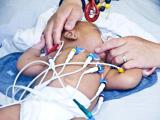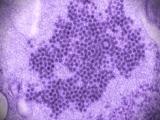A careful study of children at two Colorado and California hospitals who had polio-like illnesses strengthens the evidence that the cases were related to enterovirus-D68, which caused a widespread outbreak of severe respiratory illnesses in US children last year, according to a report published today in The Lancet Infectious Diseases.
The virus was found in 12 of 25 patients who had the polio-like condition, called acute flaccid myelitis (AFM), and the proportion probably would have been higher if respiratory samples had been collected earlier, the researchers said. In addition, a thorough genomic search for other viruses in the neural fluid of 14 of the patients found no signs of any other virus that could have caused the patients' limb weakness and related problems.
"These findings strengthen the putative association between enterovirus D68 and acute flaccid myelitis and the contention that acute flaccid myelitis is a rare yet severe clinical manifestation of enterovirus D68 infection in susceptible hosts," the authors wrote.
EV-D68 outbreak
The US EV-D68 outbreak began last summer and continued through the fall. The Centers for Disease Control and Prevention (CDC) says that 1,153 respiratory illnesses linked to EV-D68 occurred between Aug 15, 2014, and Jan 15, 2015, in 49 states and the nation's capital. Nearly all of them were in children. There were 14 deaths among the cases.
Illnesses involving sudden limb weakness in children, associated with inflammation in the spinal cord, began occurring about the same time as the EV-D68 outbreak, and some of the patients tested positive for the virus. The CDC says it verified 115 AFM cases between Aug 2, 2014, and Mar 2 of this year.
About two thirds of the children who were followed after their illness showed some improvement in the polio-like symptoms, but only two have fully recovered, according to the CDC.
Previous studies have supported the suspicion that EV-D68 is the cause of the AFM but have not proved it. For example, a report published in January said 5 of 12 AFM patients at Children's Hospital Colorado in Aurora, Colo., were infected with the virus, and its role was supported by clinical and other evidence.
The new study focused largely on patients at the Colorado hospital and Children's Hospital Los Angeles. It included children with AFM who were treated at the two hospitals between Nov 24, 2013, and Oct 11, 2014, along with similar patients identified through statewide surveillance by the California Department of Public Health from Jan 1, 2012, to Oct 4, 2014.
The authors identified 25 children with AFM—16 from California and 9 from Colorado—and also included 2 who had enterovirus-related encephalitis, 5 who had EV-D68-linked upper respiratory illnesses, and 16 with aseptic meningitis or encephalitis who tested positive for enteroviruses.
Among the AFM patients, EV-D68 was found in respiratory secretions from 7 of 11 patients in two clusters that occurred at the peak of the 2014 EV-D68 outbreak and was detected in 12 of 25 AFM patients (48%) overall.
The AFM patients were mostly children, with a median age of 7.0 years (range, 0.3 to 73.0 years). Twenty of the 24 reported they had an upper respiratory illness (URI) that began an average of 5.6 days before AFM symptoms appeared.
Poor outcomes
The AFM patients' clinical outcomes after 30 days of follow-up were poor, with persistent neurologic deficits in all 22 patients who had available information and no or minimal improvement in flaccid paralysis in 17 patients, the report says.
A phylogenetic analysis showed that all the EV-D68 viruses associated with AFM belonged to clade B1, which emerged in 2010. Five of six polymorphisms that marked this clade are also present in neuropathogenic strains of poliovirus or enterovirus D70, or both.
The authors identified two siblings who both tested positive for EV-D68 and had a URI, but only one suffered the polio-like illness. Sequencing of the EV-D68 isolates from the two patients revealed no differences.
EV-D68 was not found in the cerebrospinal fluid (CSF) of any of the AFM patients, as assessed by clinical assays in all 25 and polymerase chain reaction in 19. The virus was found in whole-blood and stool samples of just one AFM patient, a California 6-year-old.
In hunting for other pathogens that might cause AFM, the researchers conducted metagenomic sampling of the CSF from 14 AFM patients as well as one EV-A71 encephalitis patient who was included as a positive control. They found no sequences in the AFM patients that matched with known neuropathogenic viruses, bacteria, fungi, or parasites, whereas the testing detected the EV-A71 in the control patient.
The authors conclude that the detection of EV-D68 in respiratory secretions of AFM patients "is unlikely to be incidental." In addition to the EV-D68 infections in 12 of 25 patients, they cite the timing of the AFM cases during the EV-D68 outbreak, the absence of other enteroviruses typically associated with AFM, and the results of the CSF sequencing.
As for the two EV-D68-infected siblings with different outcomes, the authors said the finding suggests that the potential manifestations of EV-D68 are broad and that individual immunologic or environmental factors might lead to different responses to infection.
"This suggests that it’s not only the virus, but also patients' individual biology that determines what disease they may present with" said senior author Charles Chiu, MD, PhD, in a press release from the University of California San Francisco (UCSF). "Given that none of the children have fully recovered, we urgently need to continue investigating this new strain of EV-D68 and its potential to cause acute flaccid myelitis." Chiu is an associate professor of laboratory medicine and director of UCSF-Abbott Viral Diagnostics and Discovery Center.
The researchers also observe that the failure to find EV-D68 in 13 of the 25 AFM patients might be explained by delayed sample collection. They said clinical samples were generally collected more than 7 days after the onset of respiratory illness, which probably reduced the yield of the virus. Moreover, for AFM patients who tested negative for the virus, samples were collected an average of about 7 days later than for patients who tested positive.
In an accompanying editorial, two Swedish experts write that AFM may not be more common in EV-D68 clade B1 infections than other clades, but that the condition may have been noticed simply because of the large number of patients infected with the strain in the recent outbreak. The authors are Helene Norder and Lars Magnius of Sahlgrenska University Hospital in Gothenburg, Sweden.
"Even though the mechanism underlying the recent global increase in enterovirus D68 infections remains unknown and whether the variations in disease manifestations are caused by viral properties or just the higher number of infected individuals, this outbreak is a wake-up call not to forget the non-polio enteroviruses, most of which have broad disease manifestations and can spread quickly over continents," they wrote.
Greninger AL, Naccache SN, Messacar K, et al. A novel outbreak of enterovirus D68 strain associated with acute flaccid myelitis cases in the USA (2012-14): a retrospective cohort study. Lancet Infect Dis 2015; early online publication Mar 30 [Abstract]
Norder H, Magnius L. Can sequence data predict enterovirus D68 infection outcome? Lancet Infect Dis 2015; early online publication Mar 30 [Introduction]
See also:
Mar 30 UCSF press release
Related Jan 29 CIDRAP News story on earlier Colorado study
CDC information on EV-D68
CDC information on AFM investigation





















